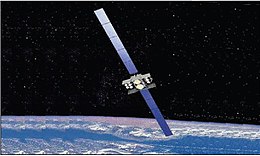USA-204
 Artist's impression of a WGS satellite in orbit | |
| Mission type | Communications |
|---|---|
| Operator | US Air Force |
| COSPAR ID | 2009-017A |
| SATCAT no. | 34713 |
| Mission duration | 14 years |
| Spacecraft properties | |
| Spacecraft type | WGS Block I |
| Bus | BSS-702 |
| Manufacturer | Boeing |
| Launch mass | 5,987 kilograms (13,199 lb) |
| Start of mission | |
| Launch date | 4 April 2009, 00:31:00 UTC[1] |
| Rocket | Atlas V 421 |
| Launch site | Cape Canaveral SLC-41 |
| Contractor | United Launch Alliance |
| Orbital parameters | |
| Reference system | Geocentric |
| Regime | Geostationary |
| Longitude | 60° east |
| Semi-major axis | 42,164.31 kilometers (26,199.69 mi) |
| Eccentricity | 0.0003615 |
| Perigee altitude | 35,778 kilometers (22,231 mi) |
| Apogee altitude | 35,808 kilometers (22,250 mi) |
| Inclination | 0.00 degrees |
| Period | 23.93 hours |
| Epoch | 31 October 2013, 15:08:48 UTC[2] |

| |
USA-204, or Wideband Global Satcom 2 (WGS-2) is an American military communications satellite which is operated by the United States Air Force as part of the Wideband Global Satcom programme. Launched in 2009, it was the second WGS satellite to reach orbit, and operates in geostationary orbit at a longitude of 60° east.[3]
Built by Boeing, WGS-2 is based on the BSS-702 satellite bus. It had a mass at launch of 5,987 kilograms (13,199 lb), and was expected to operate for at least fourteen years. The spacecraft is equipped with two solar arrays to generate power for its communications payload, which consists of cross-band X and Ka band transponders. Propulsion is provided by an R-4D-15 apogee motor, with four XIPS-25 ion engines for stationkeeping.[4]
USA-204 was launched by United Launch Alliance, using an Atlas V 421 rocket. The launch occurred from Space Launch Complex 41 at the Cape Canaveral Air Force Station at 00:31:00 UTC on 4 April 2009,[1] and successfully placed the satellite into a geosynchronous transfer orbit, from which the it raised itself into geostationary orbit using its onboard propulsion system. The satellite was designated USA-204 under the US military's designation system, and received the International Designator 2009-017A and Satellite Catalog Number 34713.[5][6]
References
- ^ a b McDowell, Jonathan. "Launch Log". Jonathan's Space Page. Retrieved 11 November 2013.
- ^ Peat, Chris (31 October 2013). "WGS F2 (USA 204) - Orbit". Heavens Above. Retrieved 11 November 2013.
- ^ Graham, William (24 May 2013). "ULA Delta IV successfully lofts WGS-5 satellite". NASASpaceFlight.com. Retrieved 12 November 2013.
- ^ Krebs, Gunter. "WGS 1, 2, 3, 4, 5, 6, 7, 8, 9, 10". Gunter's Space Page. Retrieved 11 November 2013.
- ^ McDowell, Jonathan. "Satellite Catalog". Jonathan's Space Page. Retrieved 11 November 2013.
- ^ "UCS Satellite Database". Union of Concerned Scientists. 1 September 2013. Retrieved 11 November 2013.
